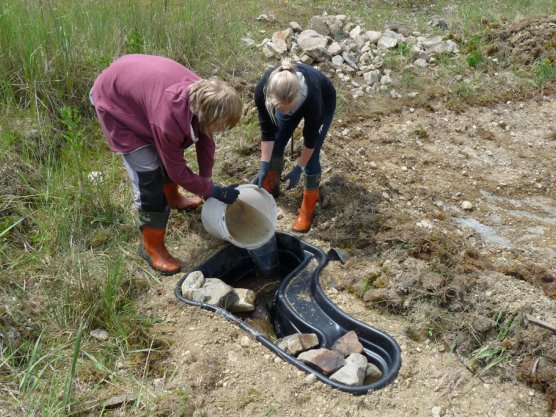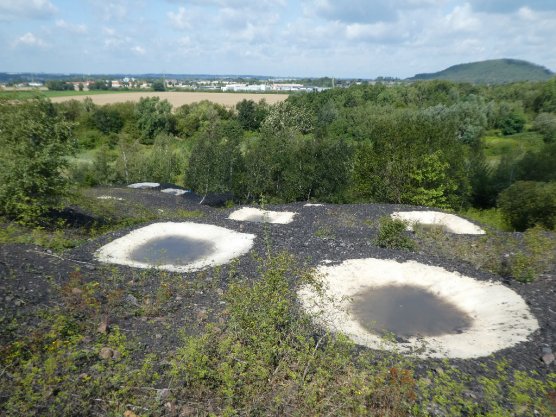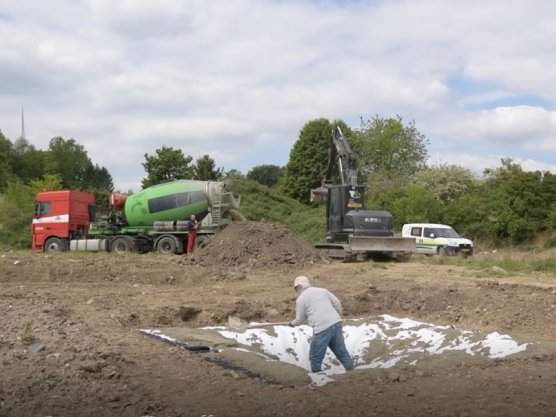
A conservation project for rare toads in the StädteRegion Aachen

Robust, easy to maintain and species-appropriate breeding ponds
Construction, installation and maintenance in detail
In this project more than 600 breeding ponds for the three target species are to be created or restored.
A particular challenge in that is to create a body of water that does not leak and remains permanently intact, yet still has its pioneer character, typical of natural breeding ponds. Pioneer character means that the bodies of water are largely free of predators such as dragonfly larvae or backswimmers, and competitors such as common frogs, water frogs or newts. In the natural habitat of the yellow-bellied toad and natterjack toad species, the breeding ponds retain a pioneer character in that they intermittently dry out or disappear and new ones are created elsewhere.
When small bodies of water such as puddles hold water for only a limited amount of time, the enemies and competitors of these species of amphibian cannot settle in them at all, or only to a lesser extent. That is an advantage for the larvae of yellow-bellied toads, natterjack toads and also common midwife toads, but bears the risk that the body of water dries out before the metamorphosis to a land animal is complete. To counteract this, amphibian pioneer species deposit their eggs or larvae several times from spring until late summer. If the bodies of water are created in such a way that the water warms up quickly, the development from egg to larva to juvenile can be complete within a few weeks. For that reason, pioneer species prefer shallow bodies of water that warm up rapidly.
Puddles and ruts: prototype of an artificial body of water with a pioneer character
In replacement habitats, ruts caused by heavy vehicles provide bodies of water with a pioneer character par excellence. Traffic in mining areas that are in operation repeatedly creates shallow depths here and there in which the water warms up quickly and dries out to again fill up with water the next time it rains.
If mining is discontinued, the area must still be driven through, thus simulating operations. This is best done in the winter months when the animals are hibernating and also annually, so that the soil compaction in the ruts creates puddles that hold water for a certain amount of time.
Such a measure is regularly carried out, for example, in the Aachen-Brand/Münsterbusch Training Area. In cooperation with the Bundeswehr-Dienstleistungszentrum Aachen (German Armed Forces Service Centre), targeted excavation and traffic flow together with military training operations here provide for amphibian breeding ponds.
Artificial bodies of water with a pioneer character requiring maintenance
Driving through many nature protection areas is either not possible or there is no compactable substrate, such as clay soil. Here, an artificial body of water with an impermeable layer can be created. Humans have to then be responsible for the “drying out” by regularly emptying the water completely and moving predators to permanent bodies of water. Until the start of the project, artificial bodies of water in the form of lined ponds and preformed plastic ponds were used by nature conservation associations such as the Nature Conservation Working Group and the Biological Station. It was found that lined ponds are difficult to clean and prone to damage. Preformed plastic ponds are basically well suited, but cleaning is time-consuming since the pond has to be completely dug out for this purpose. In areas that are accessible to the public, these ponds are also not safe from being deliberately removed or damaged.
A concrete pond – the new generation of artificial bodies of water
There are various types of concrete ponds, such as those developed in the Netherlands by the foundation "Instandsetzung von kleinen Landschaftselementen in Limburg" (IKL), that are robust and easy to maintain. They are frost-proof, safe to walk on and can be cleaned more easily without being damaged. Two types are used in the project: one is made with well casings of various sizes that are manufactured in a pre-casting plant, and the other is made with an EPDM rubber lining covered with concrete that is created on site (cast-in-place ponds).
Well casings: easy to clean, but with steep sides
Well casings with base plates all have a retrofit drain that enables them to be easily emptied in the winter months. The drainage pipe is laid on a slope and empties into a drainage basin. Up to now, casings with walls 40 centimetres high and diameters of one and two metres have been installed. Stones are laid in the casings to provide entrance/exit aids for the amphibians as well as for other animals. The stones also provide hiding places for the tadpoles and newly metamorphosed amphibians. The well casings are not suitable for natterjack toads, as these require bodies of water with very shallow embankments for their mating activities.
Cast-in-place ponds: the variable all-rounder
Cast-in-place ponds are lined ponds covered with a concrete-synthetic fibre mixture and constructed on site. They can be laid out in various sizes and depths. A prerequisite for the installation is an area that is easily accessible by an excavator and possibly also a concrete mixer truck. The soil has to be diggable, or in the case of rocky outcrop, it can be excavated.
Cast-in-place ponds can be variously shaped and also equipped with shallow embankments. This construction allows bodies of water to be created that are suitable for each of the three target species. In the project areas, cast-in-place ponds of various sizes from 5 to 80 square metres of water surface and depths of 40 to 80 centimetres were constructed. If the terrain is suitable, the ponds are also equipped with a drain.
Deep, larger cast-in-place ponds that do not completely freeze over in winter are constructed primarily for the common midwife toad so that the larvae can overwinter, if the eggs were not hatched until August. The larvae are relatively impervious to competitors, which is why cast-in-place ponds are not cleaned as frequently for common midwife toads. Yellow-bellied toads use these ponds only when they are new or have been recently cleaned.
Clay ponds – the natural alternative
On arable land, tests will be done to see if bodies of water with a clay lining are suitable. A layer of (landfill-)clay at least 50 centimetres thick is to be laid in a correspondingly deep trough and compacted.
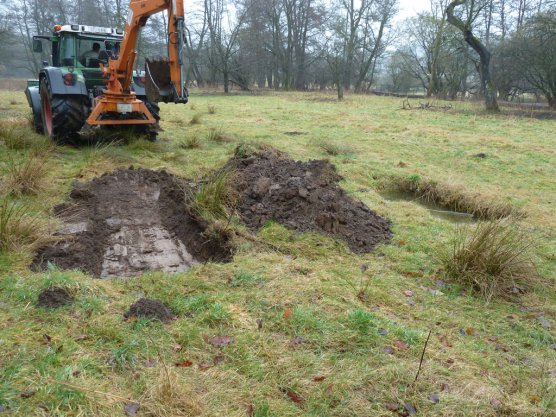 In Münsterbusch, tanks once caused ruts which filled with water; today excavators form the troughs.© Biologische Station StädteRegion Aachen e.V.
In Münsterbusch, tanks once caused ruts which filled with water; today excavators form the troughs.© Biologische Station StädteRegion Aachen e.V.
 Well casing that has been equipped with a base and a drainage pipe.© Biologische Station StädteRegion Aachen e.V.
Well casing that has been equipped with a base and a drainage pipe.© Biologische Station StädteRegion Aachen e.V.
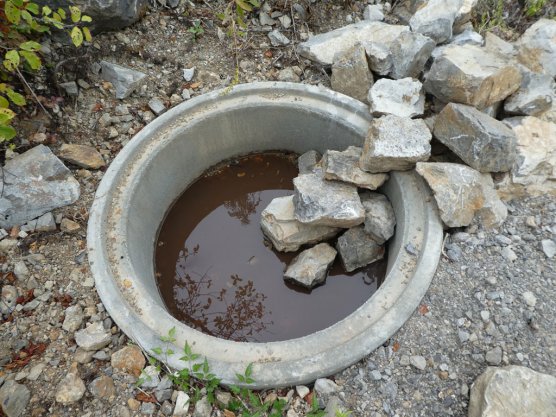 Stones serve as an exit aid for toads and other animals.© Biologische Station StädteRegion Aachen e.V.
Stones serve as an exit aid for toads and other animals.© Biologische Station StädteRegion Aachen e.V.
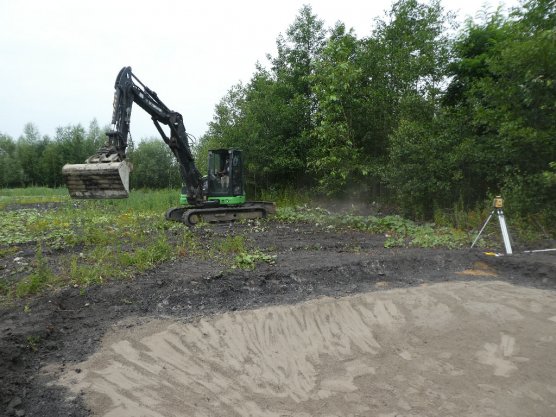 A crawler excavator is used for creating a concrete pond.© Biologische Station StädteRegion Aachen e.V.
A crawler excavator is used for creating a concrete pond.© Biologische Station StädteRegion Aachen e.V.
 Here, a number of well casings were installed to be used as breeding ponds by yellow-bellied toads.© Biologische Station StädteRegion Aachen e.V.
Here, a number of well casings were installed to be used as breeding ponds by yellow-bellied toads.© Biologische Station StädteRegion Aachen e.V.


